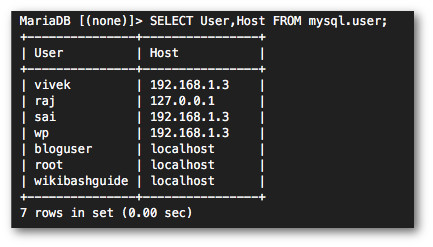However there are ways to do it. MySQL user has, then this is possible as well. Is there a way to as root and show the permissions of all users? The grants we want to show are simply the privileges which were assigned to the user account using the MySQL grant privileges command.
Learn how to grant all privileges on a database in MySQL. Get the steps from connect to your MySQL database command line tool and learn how to grant privileg. Create New User and Grant Permissions in MySQL.
MySQL is opensource and one of the most popular and widely used database management systems. After completing this tutorial, you should have a sense of how to add new users and grant them a variety of permissions in a MySQL database. From here, you could continue to explore and experiment with different permissions settings for your database , or you may want to learn more about some higher-level MySQL configurations.
Why would you want this? There are several reasons. The primary function of the MySQL privilege system is to authenticate a user who connects from a given host and to associate that user with privileges on a database. MySQL is the most popular open-source relational database management system. MySQL server allows us to create numerous user accounts and grant appropriate privileges.
To start, let’s highlight the fact that in MySQL 8. In order to be able to use a database , one needs to create: a new database , give access permission to the database server to a database user and finally grant all right to that specific database to this user. DevOps, Programming and Web Development comments. Creating a user in MySQL or MariaDB and granting permissions to him to access a specific database and be ab. Im working in an existing sytem.

In my knowldge there is supposed to have only the first line. As same as above for listing tables with given database name, we can show a list of table index and columns by providing the table name and database name. For example, let there is a users table in payload database.
MySQL is an open source relational database managed system (RDBMS) that enables users and applications to store, organize, and retrieve their data. In Mysql , SHOW command is used to get the details of database users and their privileges. Using this command we can show database and its tables and also table column, index and etc.
You may want to remind yourself how the privileges work with MySQL here before we get into more detail. SHOW DATABASES is a global privilege. This the result after granting create privilege. Introduction to MySQL roles Typically, you have a number of users with the same set of privileges. Previously, the only way to grant and revoke privileges to multiple users is to change privileges of each user individually, which is time-consuming.
Let us implement the above syntax in order to show grants from ROOT − my. This will return a list of all users with lines that look like this. If a database is not specifie then allow complete access to the entirety of MySQL.
CREATE – Allow a user to create databases and tables. DELETE – Allow a user to delete rows from a table. You must connect to the MySQL Server as a root user and perform below task: 1. Select Permission on Single MySQL Select Permission to all tables in Database in MySQL Select. GRANT permission ON database. So, to show the information for the user, you will first drop into the mysql shell.
In this article, the username will be test_db. But how do I see all the grants that madc has? MySQL grant syntax allows you to specify dynamic database names using the wildcard characters. Check the usecase of dynamic section of mysql grant syntax.
I will show the general MySQL CREATE DATABASE syntax for creating a database with a default character set. Additionally i will show how to create a user in MySQL , set him a passwor grant all privileges on this newly created database and allow him to access it locally. It does not say nor anywhere implies that SELECT privilege on individual tables in the mysql database is sufficient.
The first command (use restaurant) tells MySQL that you want to work in that database , and the second command (desc orders) shows the schema of the MySQL table named orders.
Keine Kommentare:
Kommentar veröffentlichen
Hinweis: Nur ein Mitglied dieses Blogs kann Kommentare posten.